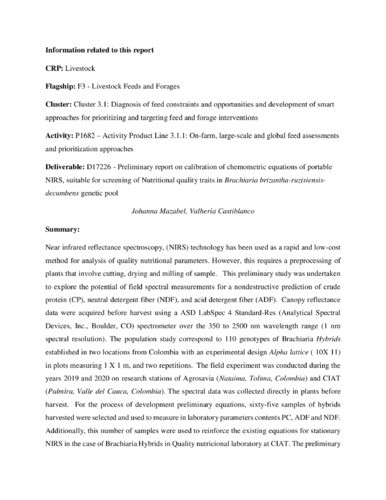Preliminary report on calibration of chemometric equations of portable NIRS, suitable for screening of nutritional quality traits in Brachiaria brizantha-ruzisiensis-decumbens genetic pool
Near infrared reflectance spectroscopy, (NIRS) technology has been used as a rapid and low-cost method for analysis of quality nutritional parameters. However, this requires a preprocessing of plants that involve cutting, drying and milling of sample. This preliminary study was undertaken to explore the potential of field spectral measurements for a nondestructive prediction of crude protein (CP), neutral detergent fiber (NDF), and acid detergent fiber (ADF). Canopy reflectance data were acquired before harvest using a ASD LabSpec 4 Standard-Res (Analytical Spectral Devices, Inc., Boulder, CO) spectrometer over the 350 to 2500 nm wavelength range (1 nm spectral resolution). The population study correspond to 110 genotypes of Brachiaria Hybrids established in two locations from Colombia with an experimental design Alpha lattice ( 10X 11) in plots measuring 1 X 1 m, and two repetitions. The field experiment was conducted during the years 2019 and 2020 on research stations of Agrosavia (Nataima, Tolima, Colombia) and CIAT (Palmira, Valle del Cauca, Colombia). The spectral data was collected directly in plants before harvest. For the process of development preliminary equations, sixty-five samples of hybrids harvested were selected and used to measure in laboratory parameters contents PC, ADF and NDF. Additionally, this number of samples were used to reinforce the existing equations for stationary NIRS in the case of Brachiaria Hybrids in Quality nutricional laboratory at CIAT. The preliminary equations designed for fresh samples and direct measurements in leave tissue of the plants before harvest and without any preprocessing (drying, milling) are still not showing satisfactory results. In contrast, the equations with dry samples presented better statistical parameters and allowed predictions to all BR interspecific population of the breeding program during 2020. In recommendation, for next studies with portable NIRS is necessary to add more samples in the process of calibration for obtain good results and equations.

